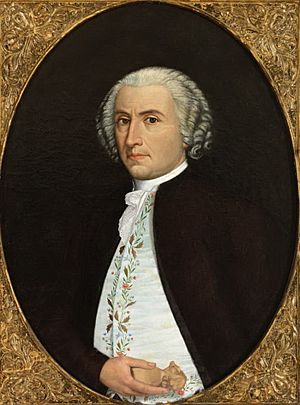Francisco Salzillo facts for kids
Quick facts for kids
Francisco Salzillo
|
|
|---|---|

Portrait of Francisco Salzillo, John Albacete (1823–1883) (Royal Economic Society of Friends of the Country of Murcia).
|
|
| Born |
Francisco Salzillo y Alcaraz
12 May 1707 Murcia, (Spain)
|
| Died | 2 March 1783 (aged 75) Murcia, (Spain)
|
| Nationality | Spanish |
| Known for | sculpture |
| Movement | baroque |
Francisco Salzillo y Alcaraz (born May 12, 1707 – died March 2, 1783) was a very famous Spanish sculptor. He is known as one of the most important Spanish artists of the 1700s, especially for his amazing Baroque sculptures. Salzillo mostly created religious art, nearly always using wood that he then painted with many colors.
He made hundreds of artworks that can be found all over the Region of Murcia in Spain, and some in nearby areas. Sadly, the Spanish Civil War (1936–1939) caused many of Salzillo's works to be destroyed. Some of his most famous pieces include his religious sculptures, his processional works (used in parades), and his large Nativity scene.
About Francisco Salzillo
Francisco Salzillo was born in Murcia, Spain. His father, Nicolás Salzillo, was an Italian wood sculptor. Francisco learned a lot from his father.
When he was twenty years old, Francisco finished a statue of St Ines of Montepulciano. His father had started this statue for the Dominicans in Murcia. After his father passed away, Francisco had to take care of his family. He organized a workshop with the help of his brothers and sisters.
In 1765, he also started a small art academy. However, it quickly closed because the members could not agree.
You can see many of Salzillo's works in Murcia. For example, the Passion of Our Lord scenes are in the Ermita de Jesús. These are large works that show all of Salzillo's skills. In the church of San Miguel, you can find an Immaculate Conception and a St Francis sculpture. Other important works include the Christ at the Well in the church of Santa María de las Gracias. There are also sculptures in San Pedro and in the Capuchin monastery in Murcia.
Salzillo mainly worked with wood. He carved his figures "in the round," meaning they were fully sculpted on all sides. After carving, his works were gilded (covered in gold) and painted with many colors. This special painting technique was called estofado.
His Main Artworks
Unlike other famous sculptors of the 1700s, like Juan Martínez Montañés or Gregorio Fernández, Francisco Salzillo did not focus too much on the sad or dramatic parts of his scenes. Instead, he explored natural beauty and ideal forms. His style helped change art from the Baroque period to the Rococo and Neoclassicism styles.
Salzillo started what is called the Murcian School of Sculpture. This style continued for a long time, and artists who followed him kept his unique way of creating figures. There is a museum in Murcia today that is dedicated to Salzillo and his art.
Here are some of his most important works:
- La Cena (The Last Supper): This piece was made in 1763. It shows Jesus and his 12 Apostles sitting around a table. There are thirteen figures in total.
- La Oración del Huerto (The Agony in the Garden): Created in 1754, this sculpture shows an angel offering a cup to Jesus. You can also see the three sleeping apostles under a palm tree.
- El Prendimiento or El Beso de Judas (The Arrest or The Kiss of Judas): Made in 1754, this work highlights the difference between Jesus's beautiful and kind face and Judas's ugly and evil one.
- Jesús en la Columna or Los Azotes (Jesus at the Column or The Flagellation): Sculpted in 1777, this piece shows Jesus with a calm and accepting look, even as he is being whipped.
- Santa Mujer Verónica (The Holy Woman Veronica): Created in 1755, this sculpture shows Saint Veronica looking sad. She holds the cloth where Jesus's face was miraculously printed.
- La Caída (The Fall): This work was created in 1752.
- San Juan (Saint John): Made in 1756.
- La Dolorosa (The Virgin of Sorrows): Created in 1756.
- El Belén (The Nativity Scene): This large scene was started by Salzillo between 1780 and 1800 and finished by his student Roque López. It has 556 small clay figures, each about 30 centimeters (12 inches) tall.
- Many small clay models, called sketches, that he made before creating his larger sculptures.
Gallery
See also
 In Spanish: Francisco Salzillo para niños
In Spanish: Francisco Salzillo para niños








